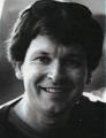| Brian
Moriarty built his first computer in the fifth grade. Oblivious
to the path that spelled out for him, he graduated from the
Southeastern
Massachusetts University in 1978 with a degree in English
Literature
Four years later,
in 1982, working as an editor at Analog
Computing magazine, he made his first experience with
an Infocom adventure, "Deadline."
Brian had already written a couple of games in BASIC, which
had been published
in Analog, and Deadline's impressive parser and depth of story
immediately got him interested. For him it must have been
the perfect mix between his geek affinity for computer technology
and his sense of the finer arts.
It
took until 1984 that Infocom offered him a job, not as author,
but as technician: Brian maintained the 6502
interpreters of ZIL
and it was his work that made the sonar in "Seastalker"
possible.
Although
it was not much later that Brian started to write his own
games. Mike Dornbrook, head of marketing, came up with the
idea of an easy adventure to introduce new adult players to
the genre and gave the project to Brian. This project became
known as "Wishbringer"
and was a solid success, selling nearly a hundred thousand
copies. Some people up to today rate it as one of the most
beautiful stories ever told in an Infocom game.
But his most ambitious
title was "Trinity,"
which, written in the final days of the Cold War, dealt with
the story of the atom bomb and nuclear war. He traveled around
the world to do research for it and even visited the "Trinity"
site,
where the world's first atom bomb was launched. Along with
Steve Meretzky's "A
Mind Forever Voyaging" the game made it clear that
serious topics can benefit from being dealt with in an adventure
game, as it gives an unusual and interactive angle on a subject.
Brian stayed with
Infocom almost up to the end and incidentally his last game
there, "Beyond
Zork," marked the final struggle of transforming
from text-only adventures to those with graphics.
It was not long
after Infocom's end that his talent took him to the most powerful
company in graphical adventure gaming in the late 80's and
early 90's, Lucas
Arts, and his first game there, "Loom"
sold over half a million copies and received several industry
awards, including MacWorld's Adventure Game of the Year.
In 1993 Brian left
Lucas Arts while doing preliminary work on "The
Dig," a space adventure. Eventually "The Dig"
was done by Sean Clark, and although Brian was credited with
"Additional Additional Story" he says he has nothing
to do with any released version of the game.
He then became
Senior Game Designer at Rocket Science, a now defunct company,
where he wrote "Lodestar:
The Legend of Tully Bodine." Not much later he and
some friends decided to form their own company, Mpath, where
they planned to write multiplayer games for the internet.
Mpath later was
renamed to Hearme,
filed bankruptcy in 2001 and Brian moved on to become Director
of Game Development at Skotos
Tech, a multiplayer gaming company specializing in interactive
fiction, where he left in 2002.
He went on to design
and present planetarium shows to finally come back to entertainment
software by joining ImaginEngine
as a Senior Producer in 2007.
Many thanks
to Brian Moriarty for contributing to this biography.
Back
to top.
|
